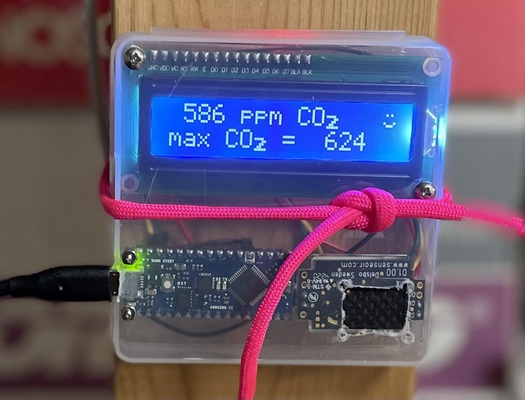My latest project is a low-cost carbon dioxide monitor.
Many workers at UW-Madison have been concerned about air quality on campus. The university has not been forthcoming about what effort they have devoted to assessing and improving air quality in campus classrooms, meeting rooms, and workspaces. (UW-Madison Facilities has an FAQ on HVAC that is shockingly offensive, even to a completely jaded employee.) And with the removal of the campus mask mandate at spring break last March, mask-wearing on campus has become a rarity.
And so we’ve started an effort to help people assess air quality in their classrooms and workspaces, beginning with measurement of CO2, which can be a good proxy to indicate air ventilation. If CO2 levels are >1200 ppm, that would indicate that the space is not getting adequate fresh air. One could then try to open doors and windows to improve ventilation, or if that is not possible, could add an air filter such as a hand-made Corsi-Rosenthal box.
The main commercial CO2 monitor is the Aranet4, which is really a beautiful device: an e-ink display, bluetooth to connect to a phone app, accurate measurements, and runs for weeks and weeks on two AA batteries. But it costs $250!
There are dozens of lower-cost alternatives, from $20-60, but none of them seem to work well at all.
And so, inspired by LibreCO2, I put together the simplest possible device using a SenseAir S8 low power sensor, an Arduino Nano Every, and a 16x2 LCD display (with an I2C chip). The cost is about $40 for the sensor, $10 for the arduino, and $5 for the LCD display, so $65. Plus a clear plastic box for 50 cents. If you order the parts from AliExpress (with a one-month lead time, buying parts for 10, and using a generic Arduino Nano v3 clone), you can get the price down to <$35 each.
The github repository for the project includes detailed assembly instructions.
There were three main challenges that we dealt with.
First, the Arduino Nano Every was a bit of a pain, in trying to upload a sketch. The Arduino IDE gives lots of error messages for these microcontrollers, and tends to hang. In the end, it seems like you try to upload a sketch once and get one error, and then you do it a second time and get a different error, but the second time actually works (though it is a pretty slow upload).
Second, I had a lot of difficulty mounting the Nano Every in the plastic box. I would have preferred to have the screws on the outside and the nuts on the inside, but there’s not any room for the nuts next to the pins, so I did it the other way around. And for many of them, I was getting an apparent short-circuit between the screw and the micro-USB, and so I generally left out one of the planned screws to next to the USB.
Third, my collaborator on this bought some LCD displays from Digi-Key that had I2C integrated, but with quite different pin-out from what I’d been using. It was a bit of a struggle to figure out how to use these, and we ended up forking the code to a separate version for these.
It’s exciting to have a few of these CO2 monitors out on campus, measuring air quality. We’re getting some data back which is in many cases good, but in at least one case very, very bad (the dreaded Humanities building).
I’m so excited that I’m now working on replacing the microcontroller with one that includes wifi access, to simplify the data gathering aspect, and to get more complete data. More to come on that.
